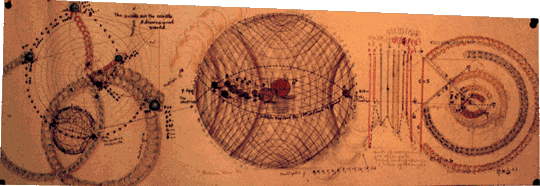
UNITS OF MEASUREMENT FOR EACH RELATIVE PITCH BASED ON THE HYPOTENUSE AND THE SIDE OF DIMINISHING TRIANGLES
The drawing on the left shows the sequence of
growth of each scale or mode. Since the first cube root is at 27, we place the
first cluster of notes with 27 as a ratio in the shortest arm, in a
counter-clockwise motion. The subsequent cubes become longer forming a spiral
(arrows). At 125, determined to be the rim of the circle, the direction changes.
The next arm almost completes the circle back to the rim and the following cube
root is found with a complete circle and over back to the rim. Between these
five steps or sequences the numbers 144 representing the note D, and 216
representing the note B are located near the rim. One arm is a multiple of 16,
the other of 18. 144 is the mystical number of ancient Chinese philosophy
denoting the receptive. 216 is the number for the creative. Together these
numbers add up to 360, days of a year, or degrees of a circle. Therefore we
might say that the world is created after six changes.
The middle section is a detail of the aforementioned world. When the
numbers at either side are taken as actual measurements, and plotted from one
side to the other to form ratios used in the first octave of a musical scale,
the notes, with the exception of B, all fall within a core...
To the right, each note is represented as if it were actually measured in
its proportion musically of relative pitch.
When we take each note with one unit as a measurement, we find that the
scale will fit into a series of sides and hypotenuses of smaller and smaller
triangles, as if each unit were divided by halves (side or hypotenuse).
C
therefore is always two sides, C' one side, F is always the hypotenuse as the
ratio of the hypotenuse to the side is roughly 4/3.
When a circle is drawn
at the point of the triangle, representing the hypotenuse as a multiple of 3,
and the side as a multiple of 2, we find that the spiral cords fit in the spaces
between each other...